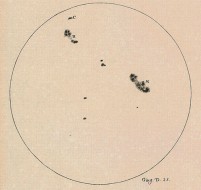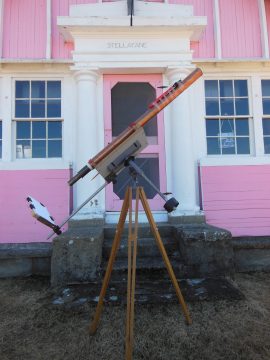Seeing Sunspots as the Ancients Did:
Astronomers have reconstructed 18-century telescopes to observe sunspots and better understand solar cycles.

Galileo
Galilei recorded this drawing of sunspots on June 23, 1613. Galileo was
one of the first to observe and document sunspots.
The Galileo Project / M. Kornmesser
The Galileo Project / M. Kornmesser
Sunspots are irregular shapes on the surface of the sun; the cooler gas, held still by strong magnetic fields, appears dark against the rest of the boiling-hot surface. The more sunspots, the more magnetically active the Sun is. Sunspot observations through the centuries have shown two long-term trends in the Sun’s activity: a possible 100-year cycle and a long-term increase in sunspot number. However, it turns out this second trend isn’t real — it’s due to inconsistencies in sunspot-counting.
A team led by Leif Svalgaard (Stanford)built 18th-century telescopes to count sunspots and record the evolution of the solar cycle in the same way as astronomers from yesteryear. The behavior of the solar cycle is crucial to studying solar dynamics, forecasting space weather, and modeling climate change. Our general understanding of the Sun relies on our knowledge about its past behavior.
Early Observations
In the early days of astronomy, sunspots were often ignored or confused for something else. For instance, in 1607, Johannes Kepler wished to observe a predicted transit of Mercury across the Sun’s disk. On the given day, he projected the Sun’s image though a small hole in the roof of his house, a camera obscura, and observed a black spot that he interpreted to be Mercury.Just a few years later, Galileo and Thomas Harriot, Galileo’s British contemporary, became the first to observe sunspots through telescopes.
Their early telescopes were far from perfect — spherical aberration, caused by the shape of the lens, was a common artifact that blurred images because light didn’t focus at a single point. Aberration coupled with small scopes and corresponding low resolution, made observing and counting sunspots a challenge.
But astronomers were game to try. From 1749 to 1796, German amateur astronomer Johann Casper Staudach observed and drew sunspots using a 3-foot “sky tube.” He drew sunspots for a total of 1,016 days, including days with no observed spots. In 1847, Swiss astronomer Rudolf Wolf started counting and recording the number of sunspots he saw every day.
Wolf used his own observations as well as Staudach’s to create the International Sunspot Number, which described the Sun’s spottedness. But this number, Svalgaard’s team realized, was inaccurate.
Counting: A Method to the Madness
When Wolf started counting sunspots, he knew two people could look through the same telescope and see two different things – after all, human vision isn’t consistent and degrades with time. He came up with the idea of not only counting sunspots, but also groups of sunspots to make a more accurate representation of the Sun.But his definition wasn’t enough: modern instruments have not only better resolution but also are free of aberrations. The improvement in clarity enables modern observers to resolve one big group of sunspots into two or more smaller groups. As of June 1st, having started on January 14th, Svalgaard’s team has produced 160 drawings over 120 days using the telescopes designed after 18th-century scopes. He’s found that on average, modern observes see about three times as many sunspots as what the ancient telescope reproductions show.
That effect is enough to explain the supposed upward trend in sunspot counts seen by other researchers — when Svalgaard accounts for the different telescopes and counting methods, the trend goes away.
How to Make an 18th-Century Telescope

John
Brigg built this solar telescope to observe and record sunspots. It's
pictured in front of the Stellafane clubhouse of the Springfield
Telescope Makers in Vermont.
J. Briggs
J. Briggs
Brigg’s replica has a clear aperture (the diameter of its main, light-gathering lens or mirror) of about 20 mm. At such a small aperture and long focal length, spherical aberration becomes less significant.
After Briggs mounted the replica on a light tripod, he projected a 3-inch solar image onto a white sheet of paper clipped to a screen. The larger sunspots were obvious, including the penumbrae, but not the smaller sunspots.
Several other members, who are also part of the team and live in different parts of the country, have made similar reconstructions and observations. “After drawing spots for six months, my expectation is that future results from a variety of telescopes will prove quite similar,” said Briggs.
The ongoing investigations were reported at the 2016 meeting of the Solar Physics Division in Boulder, Colorado. Svalgaard and his team plan to continue the project to add to existing sunspot records and aid in our understanding of the Sun’s evolution.
Oyo Rooms
Offer : Get 25% off on couples check-ins
Coupon Code : OYOCPL
Landing Page : https://www.oyorooms.com/
Affiliate URL : https://linksredirect.com/?pub_id=11719CL10653&url=https://www.oyorooms.com/deals/cpl-local%3Fid=133
Valid till : 29th June, 2016
Terms and conditions :
For check-in till 31st August
Minimum qualifying amount - Rs. 999.
Offer not valid on select hotels across India.
Offer valid on bookings made using OYO Website.
You will be entitled to a discount of twenty five percent (25%) of the booking price or Rupees One Thousand (Rs. 1000/-) whichever is less.
All bookings are subject to availability.
Discounted bookings cannot be modified.
1 comment:
Live radio online
Post a Comment